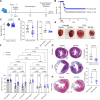Enhanced Parkin-mediated mitophagy mitigates adverse left ventricular remodelling after myocardial infarction: role of PR-364
- PMID: 39601359
- PMCID: PMC11745530
- DOI: 10.1093/eurheartj/ehae782
Enhanced Parkin-mediated mitophagy mitigates adverse left ventricular remodelling after myocardial infarction: role of PR-364
Abstract
Background and aims: Almost 30% of survivors of myocardial infarction (MI) develop heart failure (HF), in part due to damage caused by the accumulation of dysfunctional mitochondria. Organelle quality control through Parkin-mediated mitochondrial autophagy (mitophagy) is known to play a role in mediating protection against HF damage post-ischaemic injury and remodelling of the subsequent deteriorated myocardium.
Methods: This study has shown that a single i.p. dose (2 h post-MI) of the selective small molecule Parkin activator PR-364 reduced mortality, preserved cardiac ejection fraction, and mitigated the progression of HF. To reveal the mechanism of PR-364, a multi-omic strategy was deployed in combination with classical functional assays using in vivo MI and in vitro cardiomyocyte models.
Results: In vitro cell data indicated that Parkin activation by PR-364 increased mitophagy and mitochondrial biogenesis, enhanced adenosine triphosphate production via improved citric acid cycle, altered accumulation of calcium localization to the mitochondria, and initiated translational reprogramming with increased expression of mitochondrial translational proteins. In mice, PR-364 administered post-MI resulted in widespread proteome changes, indicating an up-regulation of mitochondrial metabolism and mitochondrial translation in the surviving myocardium.
Conclusions: This study demonstrates the therapeutic potential of targeting Parkin-mediated mitophagy using PR-364 to protect surviving cardiac tissue post-MI from progression to HF.
Keywords: Heart failure; Mitochondrial function; Multi-omics; Myocardial infarction; Parkin-dependent mitophagy; Proteomics; Translational reprogramming.
Published by Oxford University Press on behalf of the European Society of Cardiology 2024.
Figures






References
MeSH terms
Substances
Grants and funding
LinkOut - more resources
Full Text Sources
Medical
Research Materials
Miscellaneous

